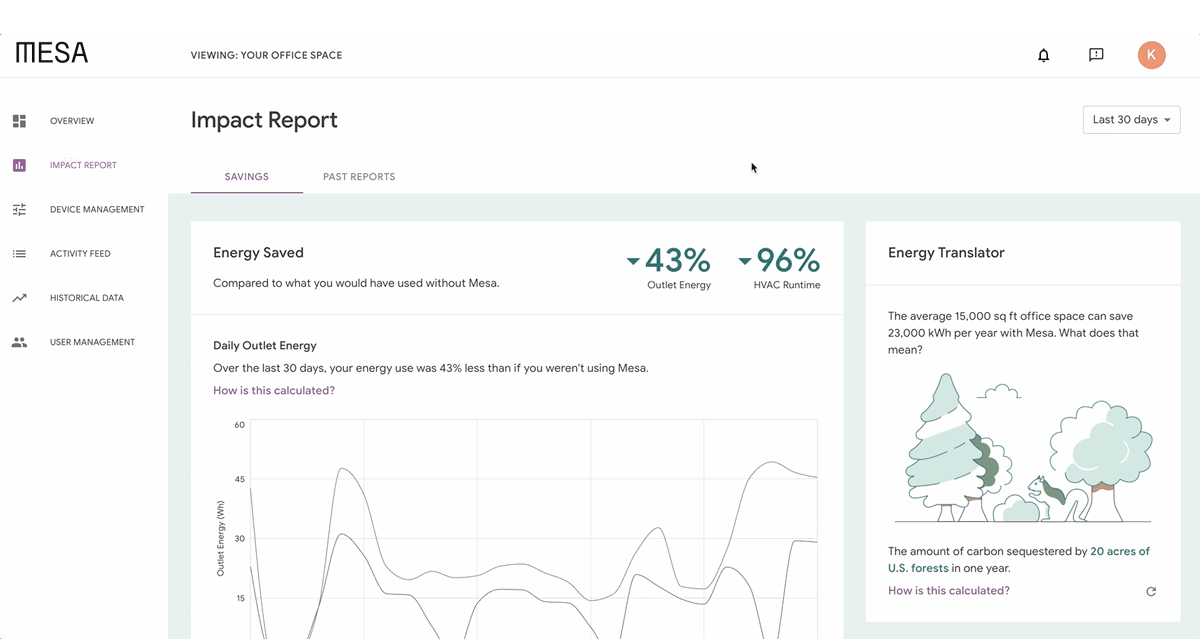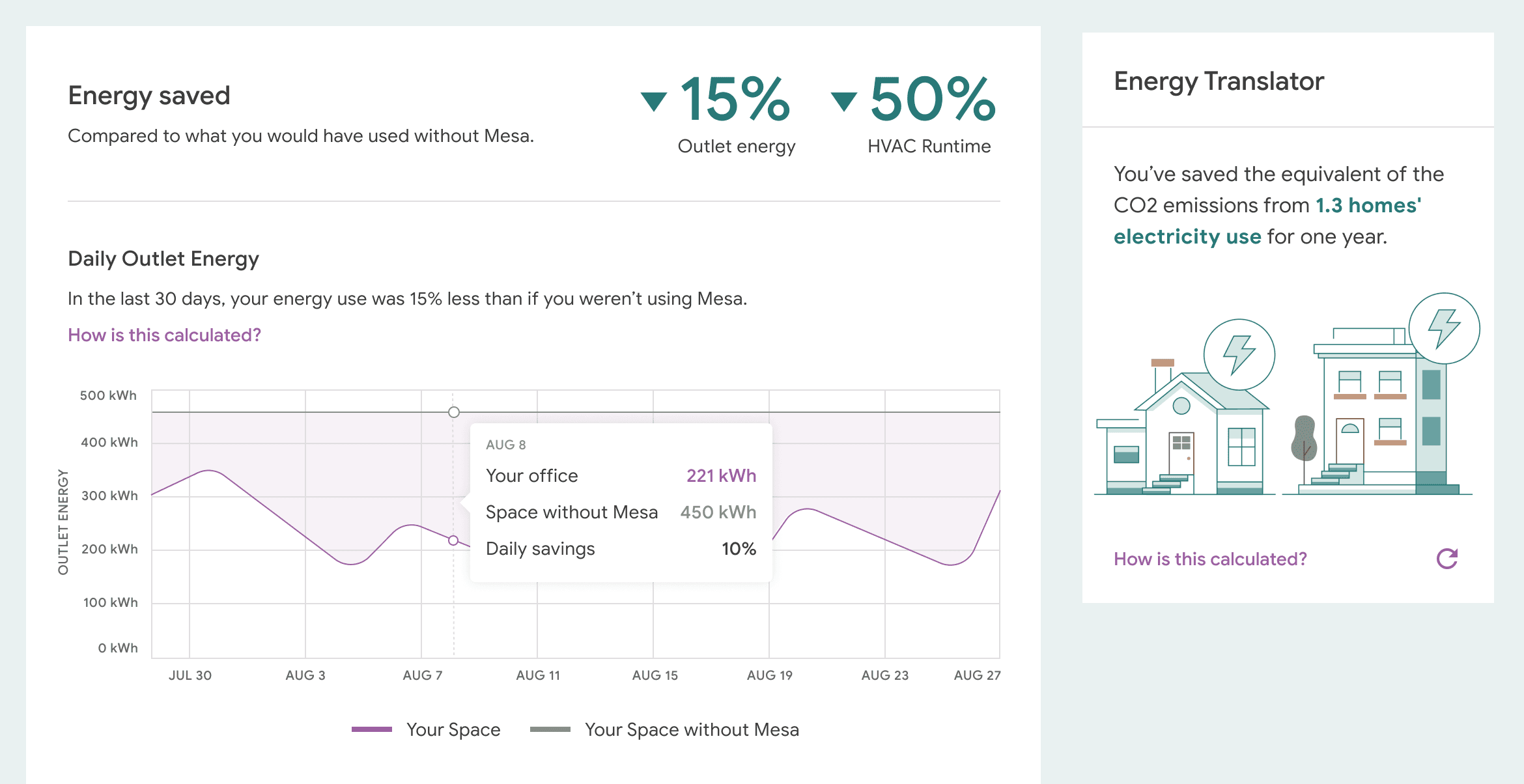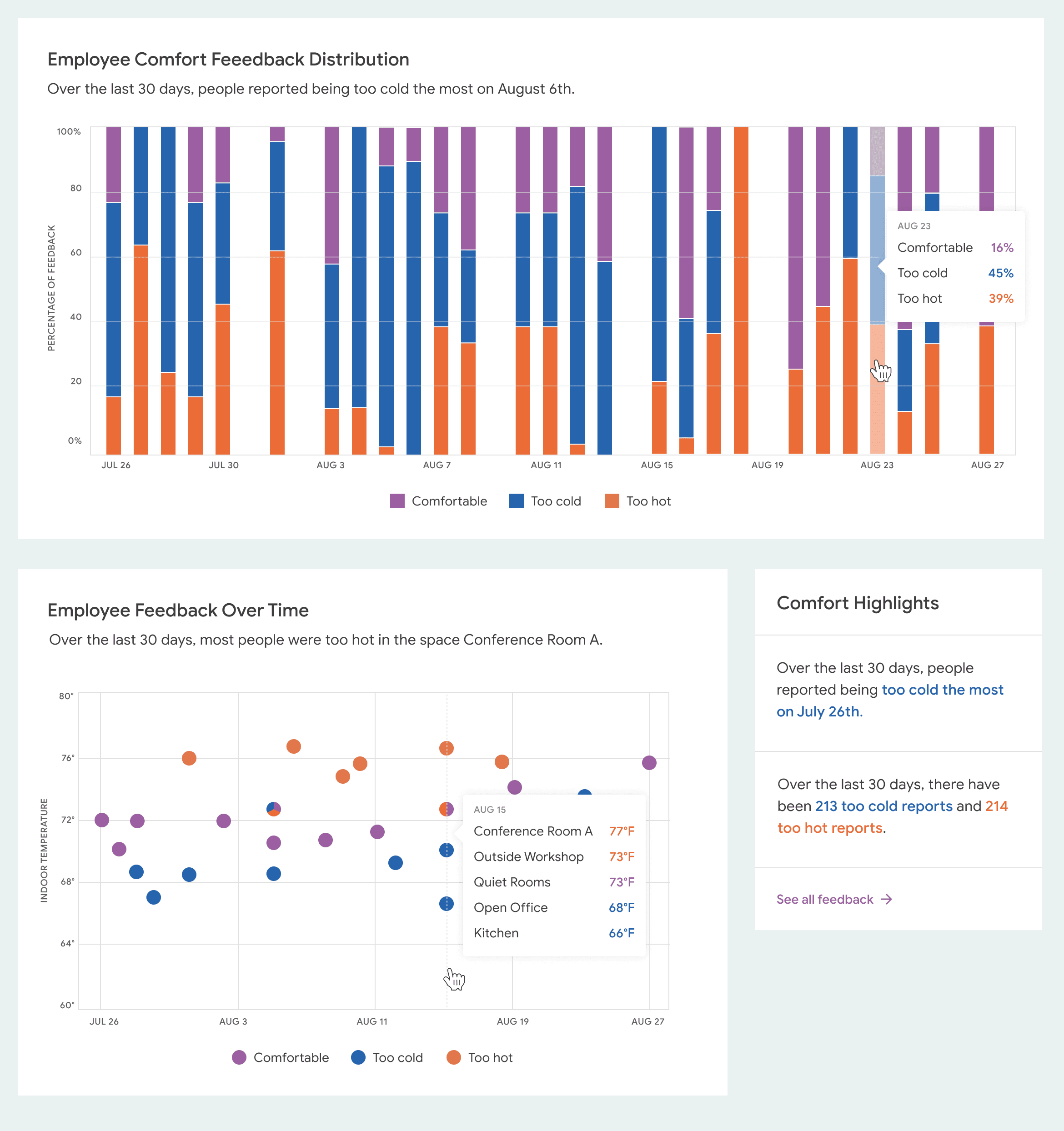Mesa
Introducing Mesa's Impact Report: See how much energy your commercial space has saved over time
Mesa's dashboard shows the automated actions the system took to conserve energy in a space. Today, we've released the Impact Report, an upgrade to the dashboard that quantifies these savings with various metrics, making it easier to connect sustainability efforts to a building's bottom line.
By Rachel Steinberg

Contact us to learn more about Mesa
Contact UsLast fall, Sidewalk Labs introduced Mesa, an easy-to-install kit that uses real-time data and automation to optimize energy efficiency in commercial spaces, specifically Class B and C buildings. Since its launch, Mesa has helped developers like Hines, a leader in sustainable development practices, reduce energy waste to save money — and the planet.
Today, we’re excited to share a new feature that will help building owners and operators see how much they are saving: Mesa’s Impact Report. Building on Mesa’s existing dashboard tools, Mesa’s Impact Report makes understanding energy savings in a space easier through quantifiable metrics. In addition to proving the positive effects of sustainability efforts on a building’s bottom line, this new addition also supports ESG (environmental, social, and governance reporting), which can help customers tie their use of Mesa to one of the toughest challenges facing commercial spaces in cities.
These savings will be reflected in three report categories: cost savings, energy savings, and occupant comfort. Customers will also be able to see which days were most energy efficient, as well as those that were most energy intensive, giving insight into further changes that can be made to optimize energy use.
Initially, the Impact Report will include two elements of the energy savings report, available to customers now, and new metrics will be added to these reports in the near future.
If you’d like to learn more about Mesa and how it can help your commercial space save money, click here or email Mesa@SidewalkLabs.com to get in touch.

A screenshot of Mesa's Impact Report, showing reductions in HVAC and outlet energy runtimes.
Energy Savings Reports
HVAC Runtime. Heating, ventilation, and air conditioning systems (HVAC) are responsible for up to 40 percent of energy consumption in commercial buildings. Because they can never be shut off entirely, they are often a reason for costly electricity bills. Since Mesa regulates the temperature of a space based on factors like occupancy levels, outdoor temperatures, and even occupant comfort levels, it can cause the time that the HVAC system is on to decrease, significantly lowering energy bills.
Customers will now be able to see how much less time their HVAC system ran with Mesa installed. Even better, they’ll see how Mesa monitored and made adjustments to the HVAC system without any action from them.
Outlet Energy. Most office equipment, like computers, monitors, TVs, conference room tech, and more, have a sleep mode. While sleep mode uses less electricity than when the device is “on,” it’s still using electricity. These vampires, as we like to call them, steadily drain electricity and covertly add to monthly bills.
Mesa’s suite of sensors and connected devices includes smart plugs, allowing Mesa to automatically turn these vampires on or off, preventing things like conference room monitors staying on overnight. Now, these automated actions will be clearly quantified with a percentage through the Outlet Energy metric.
Cost Savings Reports
Modeled Cost Savings. This metric will show how much money would have been spent on electricity, compared to the space before the Mesa system was installed.
Occupant Comfort Report

Each Mesa kit includes Thermal-Comfort Survey Buttons that collect feedback on a space's temperature. The results collected through these buttons will soon be aggregated and included in the Impact Report.
Employee Comfort Report. Every Mesa kit comes with Thermal-Comfort Survey Buttons that allow occupants in a space to share feedback on how comfortable they are with the temperature (e.g. too hot, too cold, or just right). Soon, the Impact Report will aggregate the results of this feedback, in addition to where these comfort levels were reported. For example, knowing most people reported that Conference Room A was too hot, but Conference Room B was too cold, reveals trends that can help with energy optimization.
The path to a more sustainable, greener future can be challenging for Class B and C commercial buildings. Budget constraints, lack of advanced building management systems, and the complex installation process for energy efficiency upgrades can all be blockers that prevent these types of buildings from achieving sustainability goals. Mesa removes these blockers by providing a cost-efficient solution for automating energy use, and the ease of self-installation, which can be completed in just two hours, only adds to its benefits for these buildings.
Justifying the expense of energy efficiency upgrades, no matter how large or small the cost, can also be a deterrent for energy efficiency upgrades in Class B and C buildings. The addition of the Impact Report clearly connects energy reduction with lowered energy bills, further validating a building owner, manager, or operator’s decision to use Mesa, which pays for itself in just two years of energy savings.
If you’d like to learn more about Mesa and how it can help your workplace, click here or email Mesa@SidewalkLabs.com to get in touch.